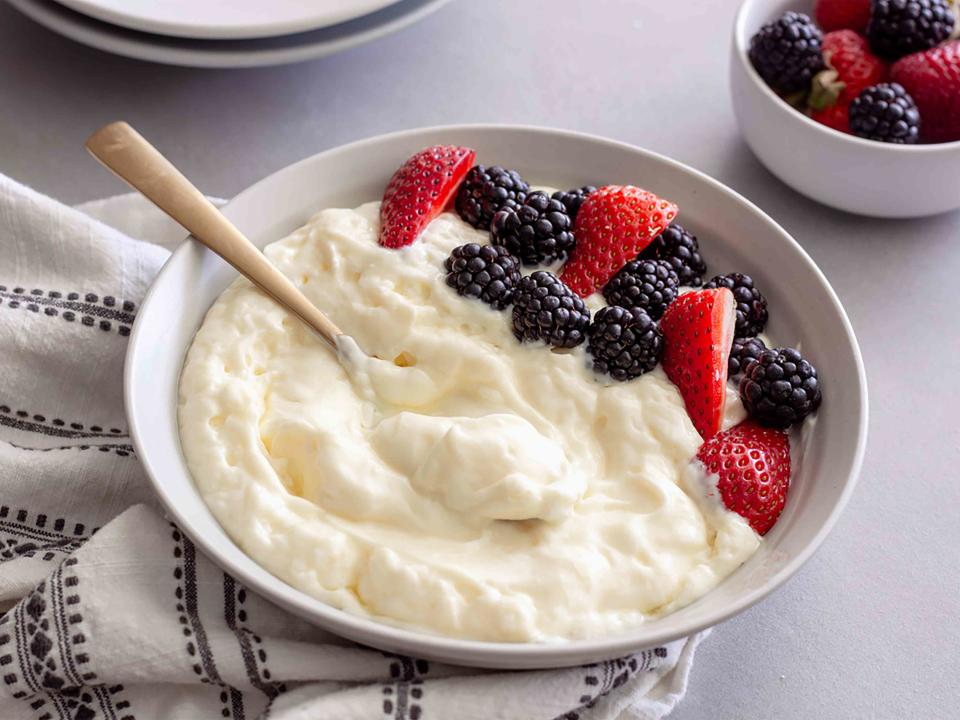You’ll Never Guess What People Are Putting in Their Yogurt Right Now
A problematic trend that technically works.

Adam Dolge
TikTok has excellent cooking content as creators share mouthwatering recipes, meal prep hacks, and healthy tweaks on classic dishes. You can find plenty of trendy cooking shorts if you are willing to scroll. Yet, just because a trend works doesn’t necessarily mean it’s worth your time.
One recent trend is adding baking powder to a combination of Greek yogurt and packaged pudding mix to create light and fluffy yogurt. Often, people add a sweetener like stevia or sugar and sometimes protein powder (this appears to be popular within the fitness community). While adding baking powder does create a fluffy, cheesecake-like, protein-packed yogurt, this is one viral recipe you may want to skip.
As a professional recipe developer, I love finding simple tricks to make food fun and exciting. Plus, thanks to my nerd-like obsession with food, I am passionate about understanding how a recipe works. So when Allrecipes asked me to give feedback on this fluffy yogurt trend, I tested about a dozen versions, trying different types of yogurt, adjusting the quantity of baking powder, using baking soda instead, and even experimenting with sparkling water. I concluded that baking powder (and baking soda) should be reserved for light and fluffy baked goods like pancakes and biscuits, not your morning yogurt.
How To Make Fluffy Yogurt?
The chemicals in baking powder and baking soda are responsible for the fluffy yogurt's light and airy texture. Sodium bicarbonate, the leavening agent in baking soda, is a base that reacts with an acid to produce gas bubbles. If you ever made a volcano in science class, you know what happens when you pour vinegar on baking soda—it quickly expands, releasing lots of bubbles in the form of carbon dioxide. Baking powder contains sodium bicarbonate and an acid called monocalcium phosphate, which activates in the wet batter and releases carbon dioxide.
Since the lactic acid in yogurt (especially Greek yogurt) is relatively acidic, adding a chemical leavener creates bubbles (this reaction makes Two-Ingredient Pizza Dough possible). Note that flavored or sweetened yogurts may have a higher pH (less acidity) and will not be as light and fluffy as plain yogurt.
Many trendy TikTok cooking videos aren't great at sharing quantities, but I found one that included measurements for fluffy yogurt. To make it, mix 3/4 cup of Greek yogurt with 1 tablespoon of pudding mix of your choice, a bit of a sweetener like stevia, and 1 teaspoon (4-5 grams) of baking powder. Be sure to stir well, and you'll quickly see the yogurt look more like cheesecake filling or even a slightly thick Cool Whip.
What Does Fluffy Yogurt Taste Like?
If you aren't a fan of thick, creamy Greek yogurt, you may love the texture of fluffy yogurt. The baking powder transforms yogurt into an almost foamy, airy whipped treat.
While the airy texture may be the first thing you'll notice, the next sensation is quite off-putting, at least for my taste. The baking powder leaves a distinctly unappetizing metallic, salty, and fizzy taste that I found quite unpleasant. In all my testing, the amount of baking powder needed to change the texture of yogurt resulted in this very unfortunate taste. Sure, the pudding mix and added sweetener help mask the flavor a bit, but the aftertaste is all metallic and fizz. In fact, it left my lips feeling particularly dry for quite some time after eating the fluffy yogurt.
The metallic, salty taste of fluffy yogurt comes from the sodium bicarbonate. If you've ever taken a bite of a baked good and tasted metal, someone likely didn't properly incorporate the baking soda or powder.
Is It Safe to Add Baking Powder or Baking Soda to Yogurt?
Generally, it’s safe to eat raw baking soda and baking powder, as the U.S. Food & Drug Administration (FDA) classifies baking soda as “Generally Recognized as Safe.” Baking soda, in particular, is used for a host of home remedies, from toothpaste and homemade antacids to laundry detergent and window cleaner. There is one important caveat: consuming too much can actually be poisonous.
According to Poison Control, ingesting too much baking soda could lead to vomiting and diarrhea as your body reacts to the high concentration of sodium. If your body is able to absorb the sodium, it can lead to seizures, dehydration, and even kidney failure. Baking soda could also lead to breathing issues and stomach ruptures.
These warnings are primarily for children who eat a handful of baking soda, but even the relatively small amount used in this recipe may be problematic for some. The smallest amount of baking powder that provided a significant texture change in a serving of yogurt was 3 grams, which equals about 3/4 teaspoon. This means the baking powder added about 400 milligrams of sodium, which is about the same amount in a large McDonald’s French fries (although about half that in a Starbucks Spinach, Feta, and Egg White Wrap). The same amount of baking soda has even more, closer to 800 milligrams. That’s a big share of the 2,300 milligrams the FDA recommends Americans consume in a single day.
While I can see why the trend of adding baking powder to yogurt for a fun texture is popular, I would instead recommend simply using whipped yogurt or making your own by whisking yogurt with some heavy cream. Heck, you may get similar results by stirring some cottage cheese into yogurt, and you won’t have to deal with the salty, metallic taste of the baking powder. Who knows, maybe fluffy yogurt and cottage cheese will be the next trend.
Read the original article on All Recipes.

